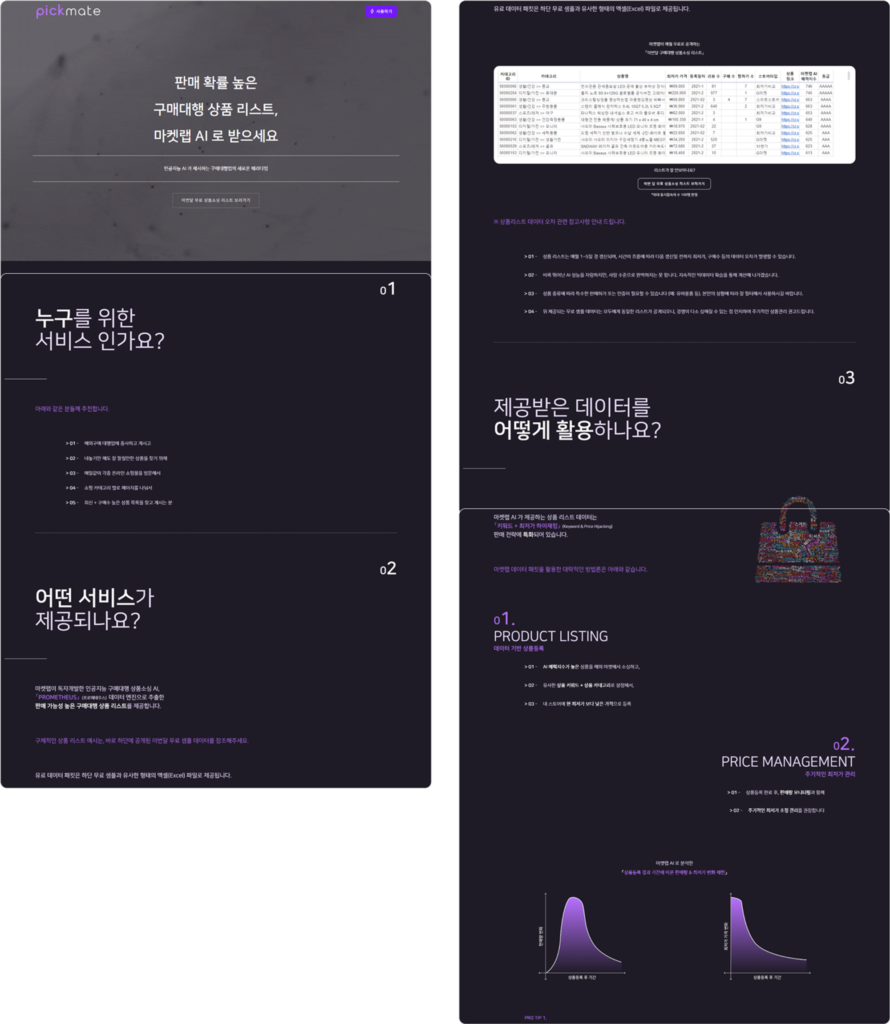Powerful Marketplace AI engine that analyzes and provides list of ‘drop-shipping’ products that will sell like crazy.
#AI/DATA #E-Commerce #B2B #WEB
#EXIT (M&A/BUY-OUT)

Pickmate — Powerful Marketplace AI engine that analyzes and provides list of ‘drop-shipping’ products that will sell like crazy.
Starting in the mid-2010’s, ‘drop-shipping’ businesses were blooming.
The basic idea behind ‘drop-shipping’ is:

The ‘get-order-first, then-procure-later’ business structure were deemed very lucrative for many aspiring, young entrepreneurs because (1) it is a very low-risk operation, and (2) anyone can start with very little upfront cost.
The key to the success of drop-shipping business is in identifying products that will sell well.
The customers are already aware of what items to buy, and is searching the keywords in Google, Amazon or eBay to make a purchase. As long as the seller is aware of what keywords and items will be searched for, the seller can easily convert sales revenues through keyword acquisition, without having to spend top-dollars in advertising.
In the end, (1) finding products that will sell well, and (2) identifying appropriate keywords for the items — are the cornerstone to the success. If the seller is lucky, he/she can generate huge revenue without having to do a lot of work. If unlucky, all the hours spent to list the hundreds, if not thousands, of items will simply go to waste with no profit.
While investigating the industry, we came up with an interesting hypothesis to utilize AI and data to boost sales revenue in drop-shipping.
Within a month, we have contracted with an outside software engineer to build our first AI engine prototype (codename: Prometheus) with the following core features:

Although the logic to use data-mining and AI to predict future sales prospect seemed very promising, we had to test to see if the data can actually provide sales boost to drop-shippers.
To confirm the efficacy of our AI approach, we partnered up with a veteran drop-shipper to conduct our official technical PoC test. We gave our partner drop-shipper an unlimited, free access to the AI engine, and he utilized the exported product & keyword list to start selling on various platforms.
Within the first month, the sales amount was around $10,000 USD, and it reached to $41,000 USD in the following second month. With total sales amount of $51,000 USD in two months, we have successfully concluded our technical PoC test with proven efficacy.
Now that the sales boosting efficacy of our AI product had been proven, it was time to test for our business model: selling & monetizing from data access.
We initially wanted to create an automated ‘platform’ where users can simply come in, sign-up, pay, and start extracting data at will. However, the development cost for such platform were very high and we weren’t really sure if our customers would actually want to pay money to get access to the data. Judging from the end-result of the technical PoC test, we knew the data generated by our AI engine was worth a lot, but we just didn’t know if our customers were ready to pay.
With such risk in mind, we have decided to stay lean and conduct a market-demand test before actually hiring an expensive engineering team. As for this reason, we built and published a landing page website that (1) introduced our AI product, (2) included a payment feature, and (3) automatically redirected customers to a portal where they can download the data in an Excel file format.

Although the quality of user experience & usability of the prototype is significantly less than that of the ‘automated platform’ we initially wanted, we could test to see (1) if such ‘high-value data delivery’ is something that our customers actually wanted, and (2) if the customers are willing to pay for such access.
Should it be clear from our prototype test that our customers are wanting our product, and they are paying for it, then we’ll go ahead and fix the UX & usability issues by building an actual platform.
Using the landing page + data (Excel) file download prototype, we beta-launched our product to test the market demand. Our customers were (1) directed to our landing page, (2) learned about our product and data, (3) made a purchase order of our data, and (4) received the Excel file that contained the product listing data.
To infiltrate our initial target market, we focused on cold-mailing method.
Gather email address through drop-shipping related communities
At the time, drop-shipping was one of the hottest entrepreneurial projects in the internet. With the frenzy, there were numerous web communities that were dedicated to teach & connect drop-shippers.
Many of these communities included posts that were advertising drop-shipping course enrollment, and people who were interested in enrolling in the course were commenting their email address to receive relevant files.
We found our lead collection opportunity here, and we created a quick and simple crawling software to scrape the email addresses in the comment section in bulk. Within 1 week, we were able to collect over 1,000 email addresses of people who were currently in the business of drop-shipping, or were highly interested in being one.
Gather email address through drop-shipping commerce websites
It’s a no brainer, but most of the drop-shipping commerce websites included official business identification information (the name of the CEO, business identification number, address, phone # and email address), as it is required by the law or merchant processing services to publicly display such information.
We took advantage of this opportunity, and used a crawling software we developed to quickly scrape the email addresses. After about a week, we were able to extract around 900 email addresses of people who were conducting drop-shipping business.
Cold-Mailing Campaign
Using the email addresses we have collected through the two methods above, we sent out a bulk of cold-mails to introduce our AI product. Of the 1,900 email addresses, 100 failed to be sent, but the rest of 1,800 emails were successfully sent away.
Throughout the two months of our market demand test:

From the quantitative performance data, we were able to draw out the following evaluation:
In conclusion, the two months of market demand test has produced positive qualitative data that indicated a strong performance of our MVP, thus confirming our Product-Market-Fit hypotheses. We have evaluated that this product is worth allocating more resources and made further product improvements.
We decided to hire full-time engineering team to create an official ‘platform’ version of the product.

Once our platform product was live, we were able to immediately convert around 700 of our previous customers & potential customers as an active user, and our user base quickly grew to over 10,000 within the first three months.
During our first three months of operation, a bigger company that provides other kind of SaaS for drop-shippers, had reached out to us for a potential M&A deal. After about a month of negotiation, we exited the product at around $500,000 USD, effectively transferring all of our rights & knowledge of our service and customers, and shutting down our operations.